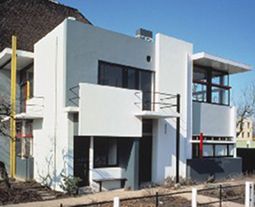Tagungsbeitrag
Van Zijl, Ida:
The restoration of the Rietveld Schröder house: a contribution to the discussion on the restoration of Modernist monuments

'The process of creating the Schröderhouse came to an end with the last restoration of the house in 1987. At that time, the house really was finished.'
Of course I realize that this statement sounds rather haughty in the ears of many people who are professionally involved in this field, but I will do my best to clarify Mulders stand and show the positive aspects of this attitude. Therefore I have to describe the historical context of the restoration. The results should be compared to those of a different approach. That is the reason why this conference is so important for the development and the exchanging of ideas on restoration of 20th century monuments.
The Schröderhouse definitely was not build for 'eternity'. Already in the 1930s Rietveld and Truus Schröder made important alterations to the interior of the house. In 1963, when the ring road in front was elevated, Rietveld suggested to demolish the house. Truus Schröder resisted his wish and instead dedicated herself to the preservation of the house for future generations. But we have to keep in mind that Rietveld preferred to destroy his own work rather than show it in a way that distorted his original concept.
In the maintaining and restoration of the Rietveld Schröder house is the definition of the original concept and the best ways to preserve and show this concept played an important role.
This subject was already a topic for Rietveld and Truus Schröder. In 1958, on the occasion of the first comprehensive exhibition of Rietveld's work, they decided to remove the added room from the roof. After Rietveld's death, Truus Schröder discussed these matters with her daughter Hanneke Schröder, an architect living and working in de United States of America, and from 1970 onwards with de board of the Foundation Rietveld Schröder house. Members of the board were, besides Truus Schröder and her children, architects, designers, and other well-known art historians, but no specialists in restoration.
However, this doesn't mean that the materiality of the house - the theme of this conference - didn't play an important role during the restoration. It did, but only in so far as it contributed to the general concept of the house. In realizing his ideas Rietveld was very much focused on the visual effects of the materials and colors he used. Therefore during the restoration process much emphasis was placed on these aspects.
In my lecture I will deal at length with the research that was done before and during the restoration, the choices that were made, and the arguments behind them.
Although the circumstances of the restoration of the Schröderhouse were quite different compared to the situation of the Villa Tugendhat, there still are lessons to be learnt out of this process.
Download
Volltext zum Download (pdf-Format, ca. 0.12 MB)
![]() Dieses Werk steht unter einer
Creative Commons BY-NC-ND 3.0 Deutschland Lizenz.
Dieses Werk steht unter einer
Creative Commons BY-NC-ND 3.0 Deutschland Lizenz.